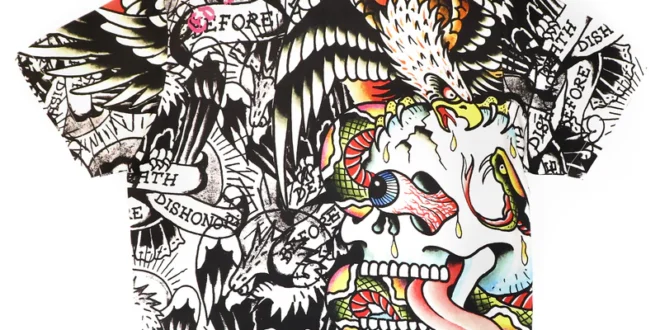Ed Hardy is a name synonymous with the fusion of tattoo artistry and fashion. ed hardy tracksuit His bold designs, rooted in traditional tattoo culture, became the foundation of a global fashion phenomenon. In an era when tattoos were still considered a niche and often misunderstood form of art, Ed Hardy brought them into the mainstream. He created a brand that revolutionized both fashion and pop culture. Through his collaboration with Christian Audigier, Hardy transformed his tattoo art into wearable fashion, pioneering the tattoo fashion movement that reshaped the industry and influenced the way people express their identity through clothing.
The Origins of Ed Hardy’s Tattoo Art
Ed Hardy’s journey began long before his name became a fashion brand. Born in 1945 in Southern California, Hardy had a passion for art from an early age. He was fascinated by the boldness and symbolism of tattoos, particularly the classic American style. Hardy’s formal art training at the San Francisco Art Institute further enhanced his skills. However, it was his exposure to Japanese tattoo art that truly shaped his unique style. Hardy traveled to Japan to study under the legendary tattoo master Horihide, where he learned the intricate techniques of traditional Japanese tattooing. This combination of American and Japanese influences would become the hallmark of Hardy’s work, blending bold colors, detailed imagery, and deep cultural symbolism.
The Transition from Tattoo Art to Fashion
Hardy’s foray into fashion was unexpected but transformative. In the early 2000s, French designer Christian Audigier recognized the potential of ed hardy tracksuit designs to cross over into fashion. Audigier approached Hardy with a vision of creating a clothing line that would feature his artwork. Hardy agreed, and the Ed Hardy fashion brand was born. The brand’s concept was simple yet groundbreaking: to bring tattoo-inspired designs to everyday clothing. Hardy’s art, which was once confined to skin, now adorned t-shirts, hoodies, and accessories. The designs were bold, rebellious, and full of attitude, capturing the essence of tattoo culture while appealing to a broader fashion-conscious audience.
The Rise of Ed Hardy in Popular Culture
The Ed Hardy brand quickly gained popularity, thanks in part to its association with celebrities and pop culture figures. During the mid-2000s, the brand became a favorite among stars like Madonna, Britney Spears, and Paris Hilton. This celebrity endorsement catapulted the brand into the spotlight, making it a must-have for fashion enthusiasts. Ed Hardy’s designs, featuring skulls, roses, tigers, and other classic tattoo motifs, became instantly recognizable. The brand’s distinct aesthetic resonated with a generation that valued self-expression and individuality. Ed Hardy clothing became a symbol of rebellion, confidence, and a love for the art of tattoos, making it a cultural phenomenon.
Tattoo Art as a Form of Self-Expression
One of the reasons Ed Hardy’s designs struck a chord with so many people is that they embodied the spirit of self-expression. Tattoos have always been a personal and meaningful art form, allowing individuals to wear their stories, beliefs, and emotions on their skin. By bringing this art to fashion, Hardy gave people a new way to express themselves. Wearing Ed Hardy clothing was more than just a fashion choice; it was a statement of identity. The designs resonated with those who wanted to break free from conventional fashion norms and embrace something edgier and more personal. Hardy’s brand made it possible for anyone to carry the symbolism and power of tattoos with them, whether or not they had ink on their skin.
The Impact on the Streetwear Movement
Ed Hardy’s influence extended far beyond traditional fashion. His brand played a significant role in shaping the streetwear movement. The combination of tattoo-inspired designs with casual, everyday clothing created a new category of street fashion that was both artistic and accessible. Streetwear, which had its roots in skate and hip-hop culture, embraced the boldness and individuality that Hardy’s designs represented. The Ed Hardy brand helped bridge the gap between high fashion and street style, making tattoo art a central element of the streetwear aesthetic. This fusion of art and fashion gave rise to a trend that continues to influence designers and brands today.
The Commercial Success of Ed Hardy
The commercial success of the brand was nothing short of remarkable. At its peak, the brand generated millions of dollars in revenue, with its products being sold in high-end department stores and boutiques around the world. The clothing line expanded to include footwear, accessories, and fragrances, further solidifying its place in the fashion industry. Ed Hardy’s designs became a global sensation, appealing to a wide range of consumers who were drawn to the brand’s unique blend of art and fashion. This commercial success demonstrated the power of tattoo art to transcend cultural boundaries and become a major player in the global fashion market.
The Decline and Legacy of the Ed Hardy Brand
Despite its early success, the Ed Hardy brand experienced a decline in popularity in the late 2000s. The brand became oversaturated, with knock-off versions flooding the market and the designs losing some of their exclusivity. Additionally, the association with reality TV stars and overexposure in the media led to a shift in public perception, with some viewing the brand as less trendy. However, the decline in the brand’s popularity did not diminish Ed Hardy’s impact on the fashion industry. The tattoo fashion movement he pioneered continued to influence designers and artists, and his contribution to the fusion of art and fashion remains significant.
The Continued Influence of Tattoo-Inspired Fashion
Even though the Ed Hardy brand may no longer dominate the fashion world as it once did, its influence on tattoo-inspired fashion is undeniable. Hardy’s work paved the way for other designers to experiment with tattoo art in their collections. Today, tattoo motifs can be found in various fashion lines, from streetwear to high-end couture. The integration of tattoo art into mainstream fashion is a testament to Ed Hardy’s pioneering vision. His ability to merge the worlds of tattooing and fashion created a lasting legacy that continues to shape the industry. The boldness and creativity of his designs have inspired a new generation of artists and fashion designers to explore the intersection of art, culture, and style.
Conclusion
Ed Hardy’s role in pioneering the tattoo fashion movement is a story of artistic innovation and cultural impact. By bringing tattoo art into the fashion world, Hardy challenged traditional notions of what fashion could be. His designs, rooted in the rich history of tattooing, became a symbol of self-expression, individuality, and rebellion. Through his collaboration with Christian Audigier, Hardy transformed his tattoo art into a global fashion brand that influenced popular culture and streetwear alike. While the brand may have experienced its ups and downs, the legacy of Ed Hardy’s tattoo fashion movement continues to inspire and influence the fashion industry to this day.




